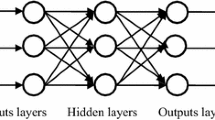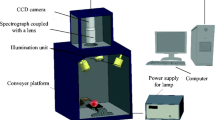Abstract
A study of multivariate analysis for orange varieties was carried out, and the potential of visible and near infrared reflectance spectroscopy (Vis/NIRS) for its ability to nondestructively differentiate orange varieties was evaluated. A total of 320 orange samples (80 for each variety) were investigated for Vis/NIRS on 325–1075 nm using a field spectroradiometer. Multivariate classification methods including principal component analysis (PCA), back propagation neural network (BPNN) and partial least squares discriminant analysis (PLSDA) were adopted to classify oranges. Sixteen principal components from PCA were used as the input of BPNN model, and the identification accuracy of four orange varieties reached 100%. The prediction result of PLSDA, i.e., standard error of prediction (SEP) 0.24497, correlation coefficient (R) 0.97843, root mean square error of prediction (RMSEP) 0.24268, and identification accuracy 90% indicate that PLSDA is an alternative model for orange identification. With the comparison of these two models, it shows that BPNN combined with PCA obtained better classification effect than that of PLSDA. The overall results demonstrate that Vis/NIRS technology with multivariate analysis models is promising for the rapid and reliable determination for identification of orange varieties.







Similar content being viewed by others
References
Moons E, Dubois A, Dardenne P, Sindic M (1997) In: Proceedings of the international conference on sensors for non destructive testing; nondestructive visible and NIR spectroscopy for the determination of internal quality in apple. Olando, Floida, Ithaca
Murray I, Aucott L, Pike IH (2001) J Near Infrared Spectrosc 9:297–311
Nilsen H, Esaiassen M (2005) Lebensm-Wiss u-Technol 38:95–99
Ventura M, Jager AD, Putter HD, Roelofs F (1998) Postharvest Biol Technol 14:21–27
Schnilovitch Z, Mizrach A, Hoffman A, Egozi H, Fuchs Y (2000) Postharvest Biol Technol 19:245–252
Bechar A, Mizrach A, Barreiro P, Landahl S (2005) Biosyst Eng 91:329–334
Cozzolino D, Murray I (2004) Lebensm-Wiss u-Technol 37:447–452
Cuadrado MU, Luque de Castro MD, Perez Juan PM, Gomez-Nieto MA (2005) Talanta 66:218–224
He Y, Li XL, Shao YN (2006) Spectrosc Spectral Anal 26:850–853
Seregely Z, Deak T, Bisztray GD (2004) Chemom Intell Lab Syst 72:195–203
Tang YF, Zhang ZY, Fan GQ (2005) Spectrosc Spectrum Anal 25:521–524
Pedro AMK, Ferreira MMC (2005) Anal Chem 77:2505–2511
Bian ZQ, Zhang XG (2000) Pattern recognition. Qinghua University Press, Beijing
Zhen WZ, Yuan HF, Xu GF, Qiang DM (2000) Modern near infrared spectroscopy analysis technology. Chinese Shihua Press, Beijing
Nigel Y (2001) Int J Food Propert 4:247–260
Downey G, Sheehan E, Delahunty C, Callaghan DO, Guinee T, Howard V (2005) Int Dairy J 15:701–709
Widyanto MR, Novuhara H, Kawamoto K, Hirota K, Kusumoputro B (2005) Appl Soft Comput 6:72–84
Tang QY, Feng MG (2002) DPS data processing system for practical statistics. Science Publishing Company Press, Beijing
Antihus HG, He Y, Annia GP (2006) J Food Eng 77:313–319
Naes T, Isaksson T, Fearn T, Davies AM (2002) A user-friendly guide to multivariate calibration and classification. NIR Publications, UK
Zhao C, Qu HB, Cheng YU (2004) Spectrosc Spectrum Anal 24:50–53
Martens H, Naes T (1989) Multivariate calibration. Wiley, New York
Blanco M, Coello J, Iturriaga H, Maspoch S, Pagès J (2000) Chemom Intell Lab Syst 50:75–82
Acknowledgments
This study was supported by the Teaching and Research Award Program for Outstanding Young Teachers in Higher Education Institutions of MOE, P. R. C., Natural Science Foundation of China, Specialized Research Fund for the Doctoral Program of Higher Education (Project No. 20040335034) and Natural Science Foundation of Zhejiang (Project No. RC02067).
Author information
Authors and Affiliations
Corresponding author
Rights and permissions
About this article
Cite this article
Cen, H., He, Y. & Huang, M. Combination and comparison of multivariate analysis for the identification of orange varieties using visible and near infrared reflectance spectroscopy. Eur Food Res Technol 225, 699–705 (2007). https://doi.org/10.1007/s00217-006-0470-2
Received:
Revised:
Accepted:
Published:
Issue Date:
DOI: https://doi.org/10.1007/s00217-006-0470-2




